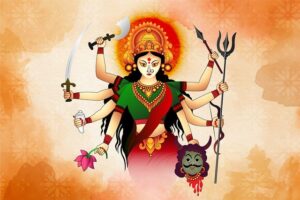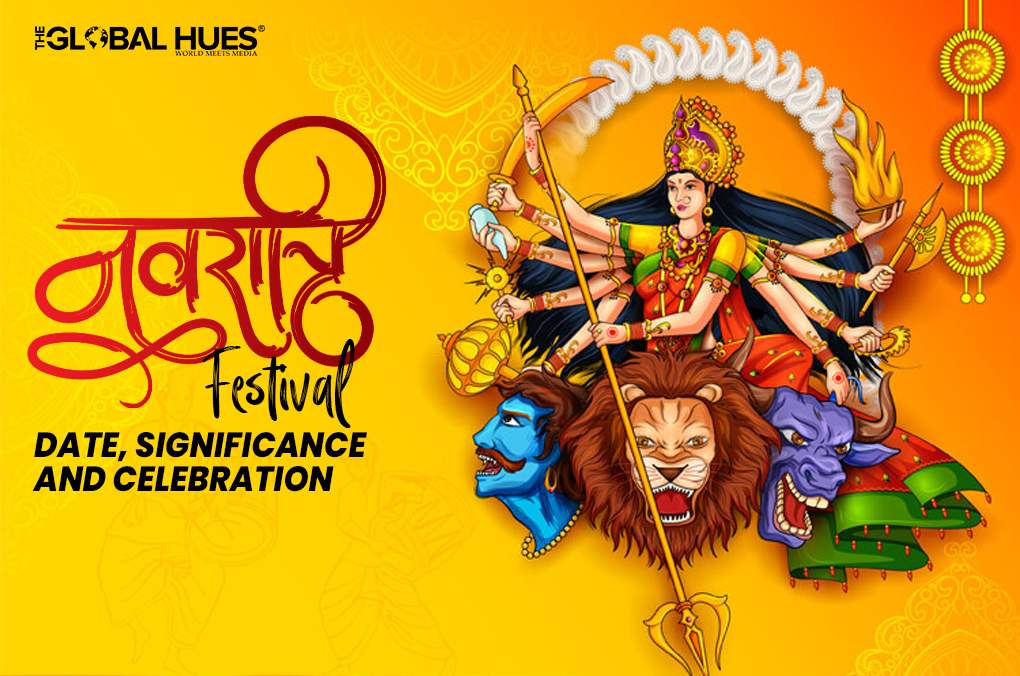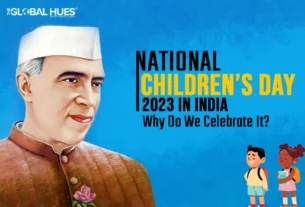Navratri which translates to ‘nine nights’ is more than just a festival for Hindus. During Navratri, people celebrate the nine forms of the Goddess Durga, with unique regional variations across the country.
People believe that during the Navratri festival, Goddess Durga defeated the demon Mahishasura, symbolizing the triumph of good over evil. People celebrate this festival by decorating their houses and temples.
In 2023, the Navratri festival will start on 15th October, Thursday and end on 24th October, Friday.
Nine Days and Forms Of The Devi
The festival of Navratri celebrates each Goddess for nine days. Below is the list of the forms of the Devi according to the days:
-
Day 1: Goddess Shailputri
Goddess Shailputri is the first form of the Goddess Durga. She holds a Trishul in one hand and a lotus in another. She rides a bull named Nandi. As the daughter of the Himalayas, she earns her name, Shailputri, where “Shail” signifies mountain. Devotees on this day should offer pure ghee to the Goddess, ensuring a life free from ailments.
-
Day 2: Goddess Brahmacharini
On the second day of Navratri, people worship Goddess Brahmacharini. She walks barefoot, holding a sacred rudraksha mala in one hand and the sacred kamandal in the other hand. Offering sugar to the Goddess increases the life of the family members.
-
Day 3: Goddess Chandraghanta
The third day is about Goddess Chandraghanta, a ten-armed goddess with a crescent moon on her forehead. She rides on a tiger, ready to destroy all that is evil. To please the Goddess, one should offer a bowl of kheer to her.
-
Day 4: Goddess Kushmanda
The fourth day is of Goddess Kushmanda, the name Kushmanda comes from ‘Ku’(small), ‘ushma’ (warmth or energy), and ‘Amnda’ (egg). It means the creator of the universe. To improve their intellect and decision-making ability, devotees should offer Malpua to the Goddess.
-
Day 5: Goddess Skandamata
On the fifth day, people worship the Goddess Skandamata. She is a four-armed Goddess who carries a lotus in both arms. She affectionately holds her son, Kartikeya, also known as Skanda, on her lap. One can offer Bananas to the Goddess as it is her favourite.
-
Day 6: Goddess Katyayani
The Goddess Katyayani is also a form of Shakti. She is known as the warrior goddess and is one of the most violent forms of Goddess Parvati. She has four arms and carries a sword. She is the daughter of Katyayan and rides a lion. Devotees should offer Honey to the Goddess.
-
Day 7: Goddess Kalratri
The seventh day of Navratri is of Goddess Kalratri. According to the legends, the Goddess sacrificed her skin colour and embraced darker skin to kill demons. She is a four-armed deity who rides a donkey and carries a sword, trident, and a noose. The third eye on her forehead contains the entire universe. Devotees should offer jaggery as prasad to the Devi to remove their pain and obstacles and bring happiness.
-
Day 8: Goddess Mahagauri
Durga Ashtami, the eighth day of Navratri, is the day of Goddess Mahagauri. She is a four-arm deity who rides a bull or a white elephant. She has a Trishul and a damru in her hands. Worshippers can offer coconuts to the Goddess.
-
Day 9: Goddess Siddhidatri
On the last day of the festival, people worship Goddess Siddhidatri. She is shown as a four-armed deity, sitting on a lotus, holding a mace, a book, a lotus and a discus in her arms. This form of Durga signifies perfection. To save yourself from unnatural events, offer Sesame seeds to the Goddess.
How Is Navratri Celebrated In India?

North India
In states like Uttar Pradesh, Delhi, and Rajasthan, celebrations of Navratri happen to commemorate the victory of King Ram over King Ravana. The burning of the effigies of Ravana symbolises the triumph of good over evil. This day is known as Vijay Dashmi or Dussehra. During the nine days, devotees pray to all the nine forms of the Goddess. On the eighth and ninth days, people welcome young girls into their homes, wash their feet, give them the prasad and offer them sweets.
Western India
In western India, Navratri is famous in Gujarat and Maharashtra. Traditional Garba and Dandiya Rasleela dances take centre stage. Dandiya Rasleela involves intricate footwork with small bamboo sticks, creating a complex yet visually stunning rhythm.
East India
In eastern India, particularly in West Bengal, Assam, and Odisha, the celebration of Navratri happens in the form of Durga Pooja. The festival includes beautifully decorated pandals along with lip-smacking food.
South India
In the southern states, the festival is all about seeing the exhibition of dolls and figurines. The doll exhibition has different names in different States:
- Tamil Nadu- Bommai Gollu
- Telugu- Bommala Koluvu
- Kannada- Bombe Habba
- Malayalam- Bomma Gullu
In Tamil Nadu, Navratri is observed as a one-day event, specifically on the ninth day, known as Ayudha Pooja. During this day, worshippers pay homage to Goddess Saraswati alongside performing the Ayudha Pooja, which involves the worship of tools and instruments.




